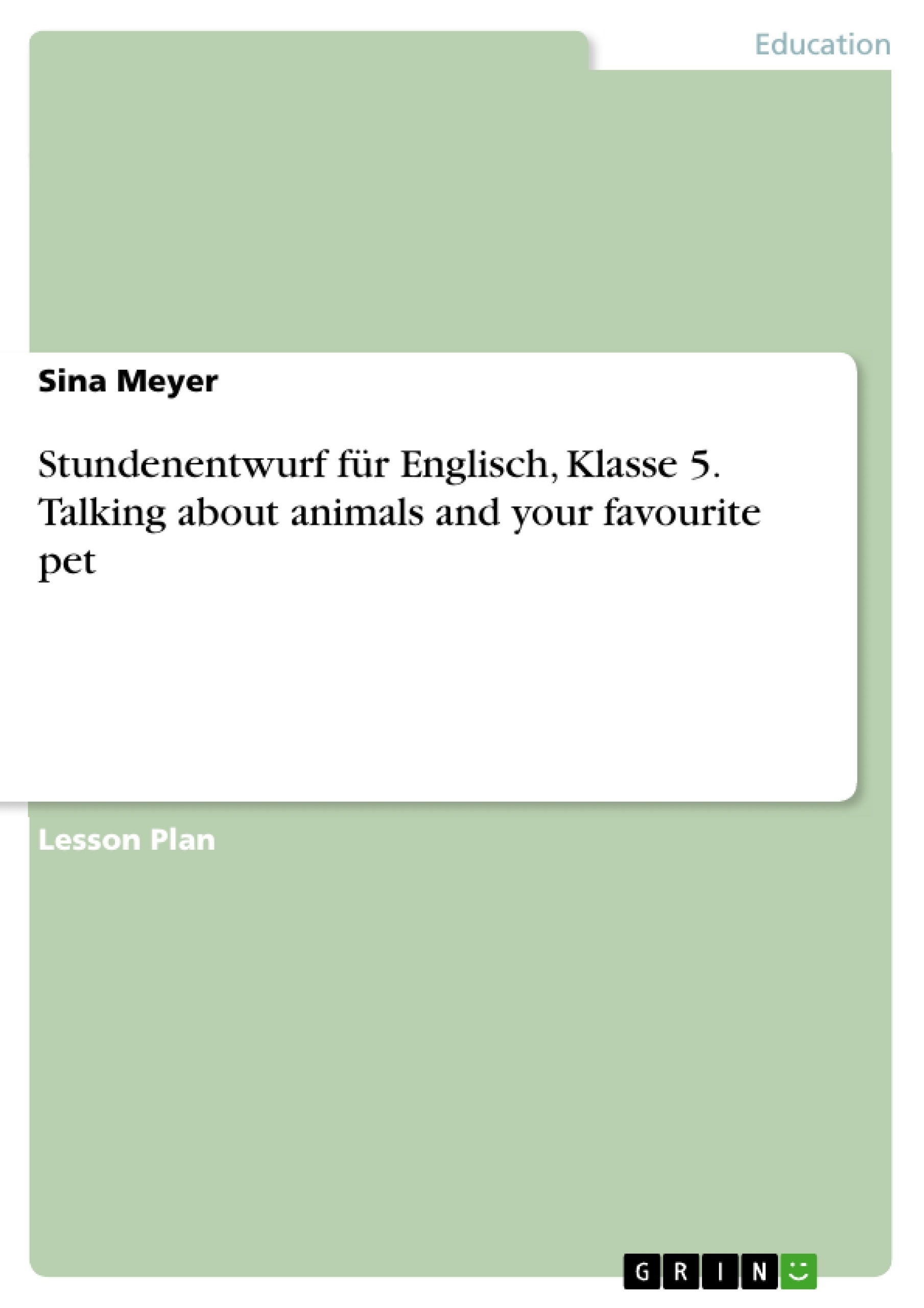“Animals” is a topic which can be related to the everyday life of the students. Many of the pupils have pets at home or they want to have one. Besides almost every student went to the zoo at least once, so they know different wild animals. That’s why every student is able to say something about this topic. It is good for them to collect information about how pets have to be held, what they eat, how long they live and what kind of costs and efforts there are when you have a pet. If they plan to buy one it can be important to know some facts.
Content
I. Written documentation of a lesson
1. Didactical considerations
1.1 Relation to the curriculum
1.2 Position of the lesson within the uni
1.3 Relevance of the topic
1.4 Didactical reduction
1.5 Objectives
2. Methodological considerations
3. Detailed lesson plan
II. Bibliography
I. Written documentation of a lesson
1. Didactical considerations
1.1 Relation to the curriculum
My planned lesson refers to different aspects of the curriculum for classes five and six in a secondary school in Baden-Württemberg. First of all there are the communicative aspects, divided in listening, speaking and reading:
For listening it is said “Die Schülerinnen und Schüler können kurze Anweisungen, Aufforderungen und Fragen verstehen und darauf reagieren”[1], which means that they can understand short instructions and questions and react. In my lesson they should understand short instructions the teacher gives them (e.g. to design a short presentation) and also have to answer questions.
For speaking the curriculum is divided into speaking in dialogue form and speaking in monologue form. For the dialogic speaking the students have to participate in conversations and they also have to know the strategies to do so. In my lesson they have to do this during the “double circle” activity. For the monologue speaking students of the fifth and sixth class have to be able to talk in related sentences and they have to be able to talk about people, animals and places. This can be seen in my lesson when they have to present their little presentation; there they talk about their favourite pet.
In the curriculum it is also said that students should know how to work with different media, for example the computer. When preparing the little presentation they can choose to work with the computer and search the internet or also work with a CD recorder.
The last aspect you can find in my planned lesson and the curriculum is the method competence: It implies different learning and working techniques and also media and presentation competences.
The working technique can be related to the preparation of the presentation, because the students can choose to work with a partner. In the curriculum team-work is very important. Focusing on the content of the curriculum students have to be able to use working techniques as brainstorming, mind mapping, visual support as word cards and when reading texts text-marking and note-taking. They can use all these techniques when working on the presentation, where they read texts or collect ideas.
My planned lesson also helps them to improve their presentation competences, as they have to present simple results and facts.[2]
1.2 Position of the lesson within the unit
Before it comes to the topic animals the students learn to introduce themselves, to talk about their favourite colours and their favourite sports and hobbies. Then the topic “animals” is introduced. The students recapitulate what they still know about animals, because they learned about animals during their time in primary school. Then they learn to say which animals they like or don’t like and which animal is their favourite one. This lesson is followed by learning to talk about favourite things. Then the next unit with the topic “school” starts.
This lesson takes place during the first weeks in class five, but because it only repeats a topic from primary school, the students should be able to know at least something about animals. The lesson belongs to the unit about talking about oneself, where pupils should be able to talk about their free time, hobbies and favourite things.
1.3 Relevance of the topic
“Animals” is a topic which can be related to the everyday life of the students. Many of the pupils have pets at home or they want to have one. Besides almost every student went to the zoo at least once, so they know different wild animals. That’s why every student is able to say something about this topic. It is good for them to collect information about how pets have to be held, what they eat, how long they live and what kind of costs and efforts there are when you have a pet. If they plan to buy one it can be important to know some facts.
1.4 Didactical reduction
This lesson focuses on speaking; it is the most important skill alongside listening during this lesson. Of course the other skills reading and writing are also included, but speaking is in the foreground. Every student gets the chance to say something. Because it is usually difficult for students to speak, I planned this lesson without new grammatical structures. I restricted them to “I like/I don't like...” and “My favourite … is...”, because the students already know these structures. It is easier for them to form sentences with well-known structures.
[...]
[1] http://www.bildung-stärkt-menschen.de/service/downloads/Bildungsstandards/WRS/WRS_E_bs.pdf
[2] Vgl. http://www.bildung-stärkt-menschen.de/service/downloads/Bildungsstandards/WRS/WRS_E_bs.pdf
- Citation du texte
- Sina Meyer (Auteur), 2014, Stundenentwurf für Englisch, Klasse 5. Talking about animals and your favourite pet, Munich, GRIN Verlag, https://www.grin.com/document/268627
-

-

-

-
Téléchargez vos propres textes! Gagnez de l'argent et un iPhone X. -

-
Téléchargez vos propres textes! Gagnez de l'argent et un iPhone X. -

-
Téléchargez vos propres textes! Gagnez de l'argent et un iPhone X. -

-
Téléchargez vos propres textes! Gagnez de l'argent et un iPhone X. -

-
Téléchargez vos propres textes! Gagnez de l'argent et un iPhone X.

